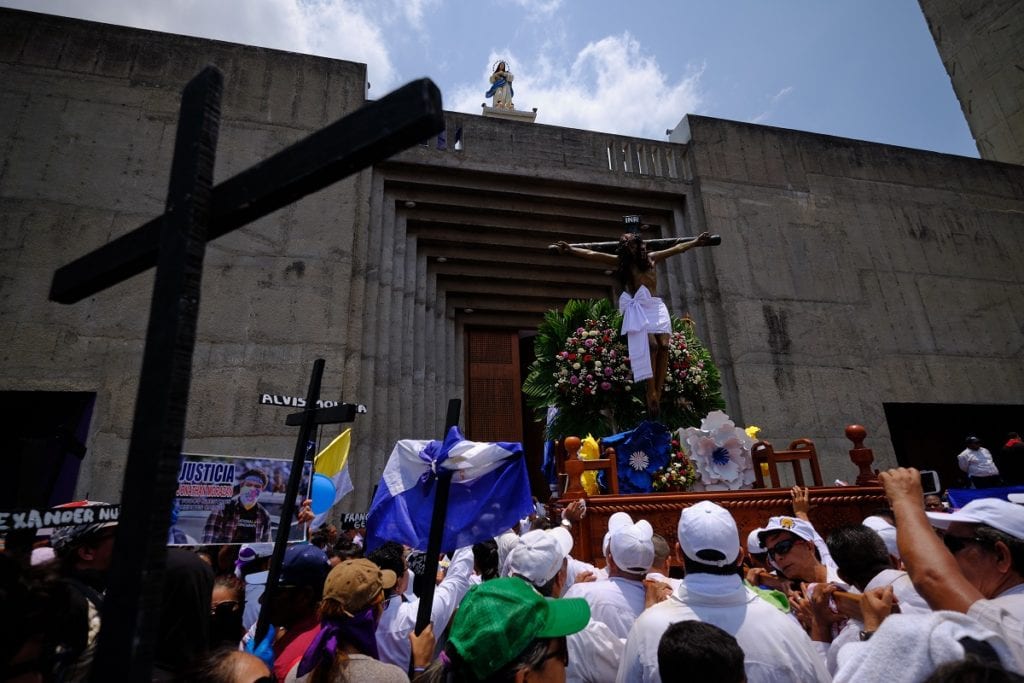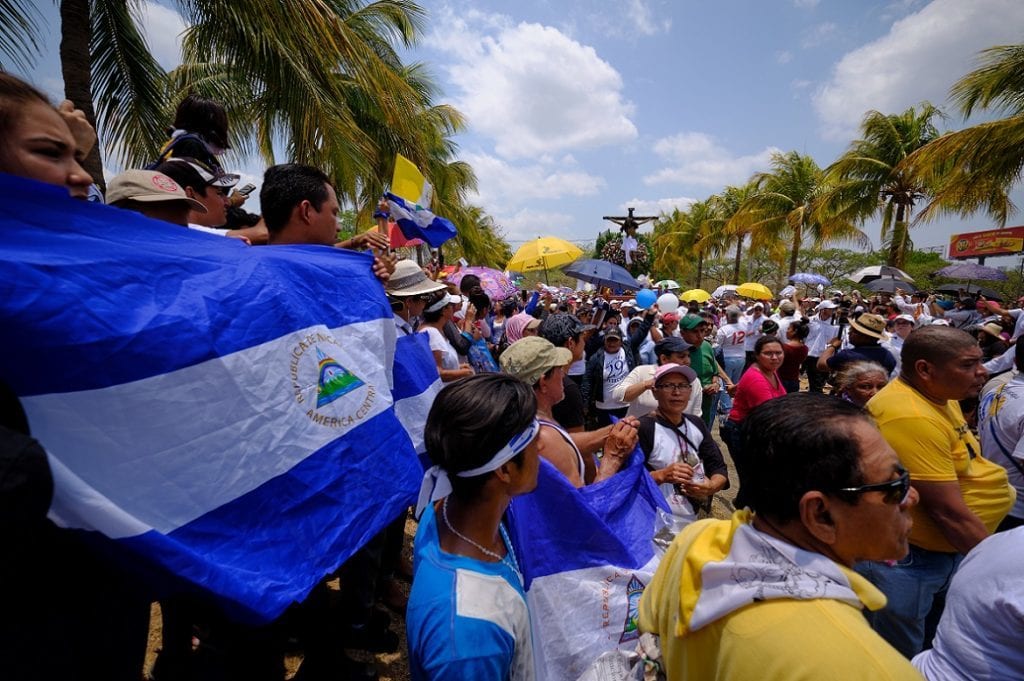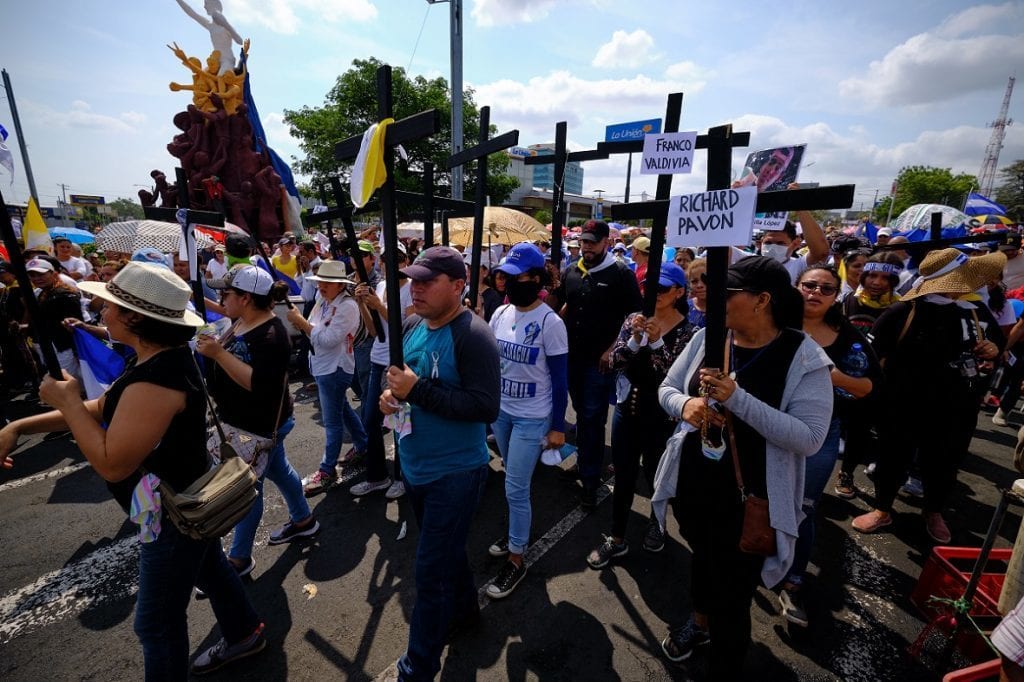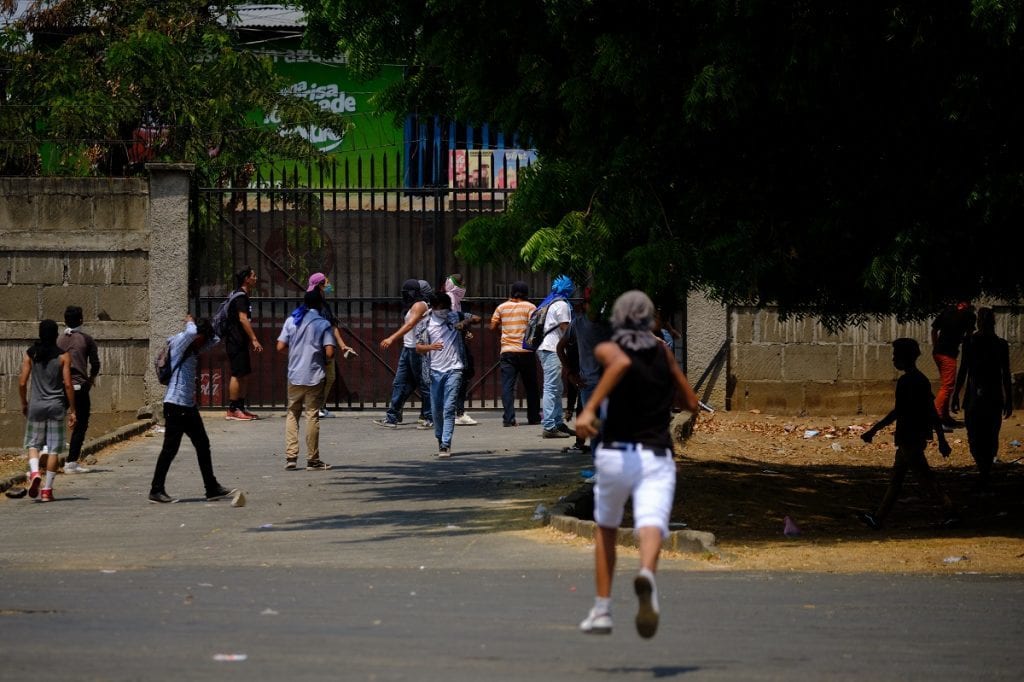A Via Crucis in a “Crucified Nicaragua”
On the anniversary of the massacre, citizens took advantage of the Via Crucis to protest and demand justice

Processions with flags and crosses as a symbol of protest; young people take a roundabout, and the Police once again intimidate and throws tear gas bombs and bullets
By Juan Carlos Bow (Confidencial)
HAVANA TIMES – “The blood of Christ has power!” “They were students, not criminals!” “Christ today, Christ forever!” “Democracy yes, dictatorship no!” These were the slogans that hundreds of citizens and worshippers chanted during the penitential Via Crucis (Way of the Cross) of this Holy Friday, in Managua, which coincided with the first anniversary of the beginning of the massacre by the police and paramilitary forces of the government of Daniel Ortega against the civic protests that began on April 18, 2018.
The traditional circuit of the “Sangre de Cristo” (Blood of Christ), in the capital, this year included the use of the national flag and crosses to remember the victims, allowing thousands the opportunity to protest with some relative safety, despite the state of exception that the dictatorship has installed de facto, since last September, and the permanent police siege, which ended up blocking the exit of hundreds of young people who made spontaneous protests after the end of the religious procession.

The Via Crucis departed at 8:00 in the morning without setbacks. Self-convoked young people groups were identified and divided. Some marched with black crosses—in commemoration of murdered protesters—and in silence. Others with blue and white flags, shouted: “They must leave, they will leave,” “Daniel and Somoza are the same thing.” Other simply prayed, carrying flags and rosaries.
The route of the image, from the gate of the Colegio Teresiano to the Cathedral of Managua, followed its traditional circuit. The young people took advantage of passing through the roundabout in Metrocentro, to wave the national flag and protest once again in a place they have not been able to make use of since September, due to permanent police patrols, since the Police criminalized all civic demonstrations.
The message of the Cardinal
The procession was headed by Cardinal Leopoldo Brenes, who at the end of the liturgy said: “We have walked for four hours, in penance, in silence, in prayer. Today, each one of us has an intention for Nicaragua, for the mothers who suffer the loss of their children, for people who are deprived of their liberty, for people who are outside our country, for all the needs of each one of us, for people who do not have a job; for those people limiting food to their children.

Brenes’ words summed up the feeling of a mass of citizens who for hours walked in silence, out of respect for religious activity, but who attended with one objective: to demonstrate their rejection of the abuses of the Ortega regime, and their demands for justice, democracy and freedom after the massacre that has left at least 325 murdered, more than 3,000 injured, dozens of missing, more than 800 political prisoners, some 60,000 exiled by the political repression and almost half a million in unemployment.
“I know that it is an act of God, but I also understand that the voice of the people is the voice of God,” said Carlos Valle, released political prisoner, who carried a banner demanding freedom and democracy.
Siege by policemen
The Via Crucis had ended with the words of Cardinal Brenes. However, at the west exit of the cathedral a detachment of riot police was waiting for the young people who had demonstrated at the Metrocentro roundabout. The police knew this and confirmed it in a statement released hours later.

In trying to justify their heavy presence the Police said in a statement: “A group of hooded people, armed with stones, mortars and some firearms tried to manipulate the Via Crucis at the cathedral. This same group of people damaged the fountain at the Ruben Dario roundabout, and they remained hooded and armed on the premises of the main church of the capital.”
However, the young people did not carry firearms and their only defense was stones which they picked up from the grounds of the cathedral. The “destruction” of the roundabout pointed out by the police were graffiti with spray paint, which minutes later was washed away by city hall workers. During the impromptu protest there were no injuries, although two young people fainted.
After the police harassment, the young people decided to barricade themselves in the cathedral, until authorities of the temple and a delegation of the Civic Alliance, led by the university student Max Jerez, tried to mediate and calm the demonstrators, who were reluctant to leave for fear of reprisals by the Police.
At the end of the afternoon, the young people decided to leave the cathedral on the promise that the Civic Alliance and ecclesiastical authorities would guarantee that they would not be persecuted by the Police. The guarantor of that commitment was Nuncio Waldemar Sommertag.

IACHR and US criticize the use of force to disperse the protest
The Inter-American Human Rights Commission (IACHR) warned that the young people who entered the Managua Cathedral after protesting against Ortega, were surrounded by a group of riot police.
“The #IACHR reminds the State that it must respect the right to protest, guarantee freedom of expression and safeguard the physical integrity of protesters in #Nicaragua,” said the entity in a tweet.
The riot police fired preventive shots and threw tear gas and stun bombs to disperse the group of “self-convoked,” mostly young people, who temporarily stopped traffic on a street next to the Cathedral, where they took refuge.
A few minutes later, at least ten patrol trucks loaded with police officers who carried out the detonations arrived at the scene.
The United States also criticized the use of force by the Government of Daniel Ortega to disperse the improvised demonstration.
“The Ortega regime holds nothing sacred, even attacking peaceful protestors & religious celebrants during #Holy Friday,” wrote Kimberly Breier, head of Latin America at the US State Department, in a tweet, distributed by the press office of the Embassy in Managua.
She added that “such desperate attempts to keep power expose Ortega’s hypocrisy & weakness of Ortega in the face of the people’s clamor for freedom #Nicaragua.”






The US has been trying to topple the Democratically elected government sense the 80s…Trump and his cronies are at it again.